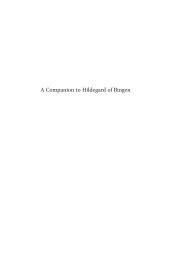Herinnering in geschrift en praktijk in religieuze gemeenschappen
Create successful ePaper yourself
Turn your PDF publications into a flip-book with our unique Google optimized e-Paper software.
childr<strong>en</strong> , 25 while the War<strong>en</strong>ne Chronicle conta<strong>in</strong>s an important and unique chapter on Ernulf of<br />
Hesd<strong>in</strong>, the crusad<strong>in</strong>g great-grandfather of Earl Patrick, which can only have come through<br />
Ala’s rema<strong>in</strong><strong>in</strong>g cordial contact with her daughter. 26 Wh<strong>en</strong> Isabel the heiress ev<strong>en</strong>tually<br />
remarried <strong>in</strong> 1164 she swapped one royal son, William IV, for a royal (half) brother Earl<br />
Hamel<strong>in</strong>. Yet, on Isabel’s part there is precious little evid<strong>en</strong>ce for special devotion to her first<br />
husband’s memory. 27 Perhaps the fact that they did not have childr<strong>en</strong> is partly to blame for what<br />
looks like a lacuna. If they had had childr<strong>en</strong> th<strong>en</strong> the demands of her as mother would have<br />
rem<strong>in</strong>ded her, if not forced her, to keep his memory alive more actively. In fact, she gave birth<br />
<strong>in</strong> quick succession to Hamel<strong>in</strong>’s childr<strong>en</strong> and was clearly fully occupied with her new life as<br />
Hamel<strong>in</strong>’s wife. What is hard for us to know is whether these remarriages were voluntary or<br />
more or less forced upon the War<strong>en</strong>ne wom<strong>en</strong> by the English k<strong>in</strong>gs. In the case of Isabel, one<br />
of the richest wom<strong>en</strong> of her time, she probably had little choice. K<strong>in</strong>g Steph<strong>en</strong> was ke<strong>en</strong> to<br />
associate the War<strong>en</strong>ne honour with his own dynasty and to this <strong>en</strong>d arranged for her to marry<br />
his second son. After William IV’s death <strong>in</strong> 1159 there is evid<strong>en</strong>ce that Isabel was <strong>in</strong>volved with<br />
K<strong>in</strong>g H<strong>en</strong>ry’s full brother William of Anjou only for this match to be halted at the order of<br />
Archbishop Thomas Becket caus<strong>in</strong>g William to have died from heart ache. 28 That it had tak<strong>en</strong><br />
more than five years after William IV’s death before Isabel planned to remarry, suggests that<br />
she may have be<strong>en</strong> affected deeply by the loss of him. In contrast, only months passed betwe<strong>en</strong><br />
William of Anjou’s death <strong>in</strong> January 1164 and Isabel’s marriage to K<strong>in</strong>g H<strong>en</strong>ry II’s halfbrother<br />
Hamel<strong>in</strong> <strong>in</strong> the late summer with the Pipe Roll of that year reveal<strong>in</strong>g that the k<strong>in</strong>g paid<br />
for her exp<strong>en</strong>ses. 29 Despite this seem<strong>in</strong>g haste, all surviv<strong>in</strong>g evid<strong>en</strong>ce suggests that the match<br />
of Isabel and Hamel<strong>in</strong> was a productive one.<br />
By way of conclusion I would argue that any discussion of a dy<strong>in</strong>g memorial tradition is <strong>in</strong><br />
effect a discussion of the birth of a new one which th<strong>en</strong>, and only th<strong>en</strong>, allows us <strong>in</strong> retrospect<br />
to id<strong>en</strong>tify the previous one as hav<strong>in</strong>g died. But one can never be categorical. As we have se<strong>en</strong><br />
<strong>in</strong> the case of the revived War<strong>en</strong>ne pres<strong>en</strong>ce <strong>in</strong> Sa<strong>in</strong>t-Bert<strong>in</strong>, memories can last long and can<br />
give the impression of hav<strong>in</strong>g disappeared only to pop up aga<strong>in</strong>. In families the fad<strong>in</strong>g away of<br />
memories is tied up with ‘mov<strong>in</strong>g on’ after death to new marriages which create new alliances<br />
and new political situations which make traditions l<strong>in</strong>ked to old alliances less appropriate, less<br />
relevant, and less urg<strong>en</strong>t. H<strong>en</strong>ce old traditions are easily supplanted. Yet, there is always the<br />
danger on our part that we forget that many memories rema<strong>in</strong>ed unrecorded and may have<br />
survived <strong>in</strong> other ways, orally, attached to objects or otherwise. As historians we must be<br />
extremely careful <strong>in</strong> our <strong>in</strong>terpretation of sil<strong>en</strong>ces. In <strong>in</strong>stitutions there is oft<strong>en</strong> a more flu<strong>en</strong>t<br />
transition from one tradition to the next due to the writt<strong>en</strong> record leav<strong>in</strong>g a paper trail. This<br />
too, however, can be mislead<strong>in</strong>g, if historians argue that the <strong>in</strong>stitutional memory repres<strong>en</strong>ts<br />
a liv<strong>in</strong>g tradition on the part of the families associated with monastic houses.<br />
25<br />
Early Yorkshire Charters. Vol. VIII, no. 111; Van Houts, ‘The War<strong>en</strong>ne View of the Past, 1066-1203’, p. 114.<br />
26<br />
The War<strong>en</strong>ne Chronicle, ed. van Houts and Love, par. 21 (Hyde Chronicle, ed. Edwards, pp. 301-02).<br />
27<br />
He is never m<strong>en</strong>tioned explicitly by name or as Isabel’s first husband, and only occurs <strong>in</strong> refer<strong>en</strong>ces such as ‘all<br />
earls of War<strong>en</strong>ne’ (Early Yorkshire Charters. Vol. VIII, no. 59, pp. 105-06, or ‘all my [sc. Hamel<strong>in</strong>’s] predecessors’<br />
(Early Yorkshire Charters. Vol. VIII, no. 54, p. 101, no. 64, pp. 110-11; ‘all counts and countesses of War<strong>en</strong>ne’ <strong>in</strong><br />
a jo<strong>in</strong>t charter of Hamel<strong>in</strong> and Isabel (Early Yorkshire Charters.Vol. VIII, no. 74, p. 116). It is noteworthy that<br />
William IV is actually overlooked <strong>in</strong> a jo<strong>in</strong>t charter by Hamel<strong>in</strong> and Isabel for Southwark priory that <strong>en</strong>umerates<br />
<strong>in</strong>dividual earls (Early Yorkshire Charters.Vol. VIII, no. 80, p. 123 note).<br />
28<br />
‘The ¨Draco Normannicus¨ of Eti<strong>en</strong>ne de Rou<strong>en</strong>’, ed. R. Howlett, Chronicles of the Reigns of Steph<strong>en</strong>, H<strong>en</strong>ry<br />
II and Richard I, ed. R. Howlett, 4 vols (London, 1884-9), vol. II, pp. 589-762 at p. 676.<br />
29<br />
Early Yorkshire Charters.Vol. VIII, p. 18 (refer<strong>en</strong>ce to Pipe Roll 10 H<strong>en</strong>ry II, p. 20 [Michaelmas 1164]).<br />
35
















